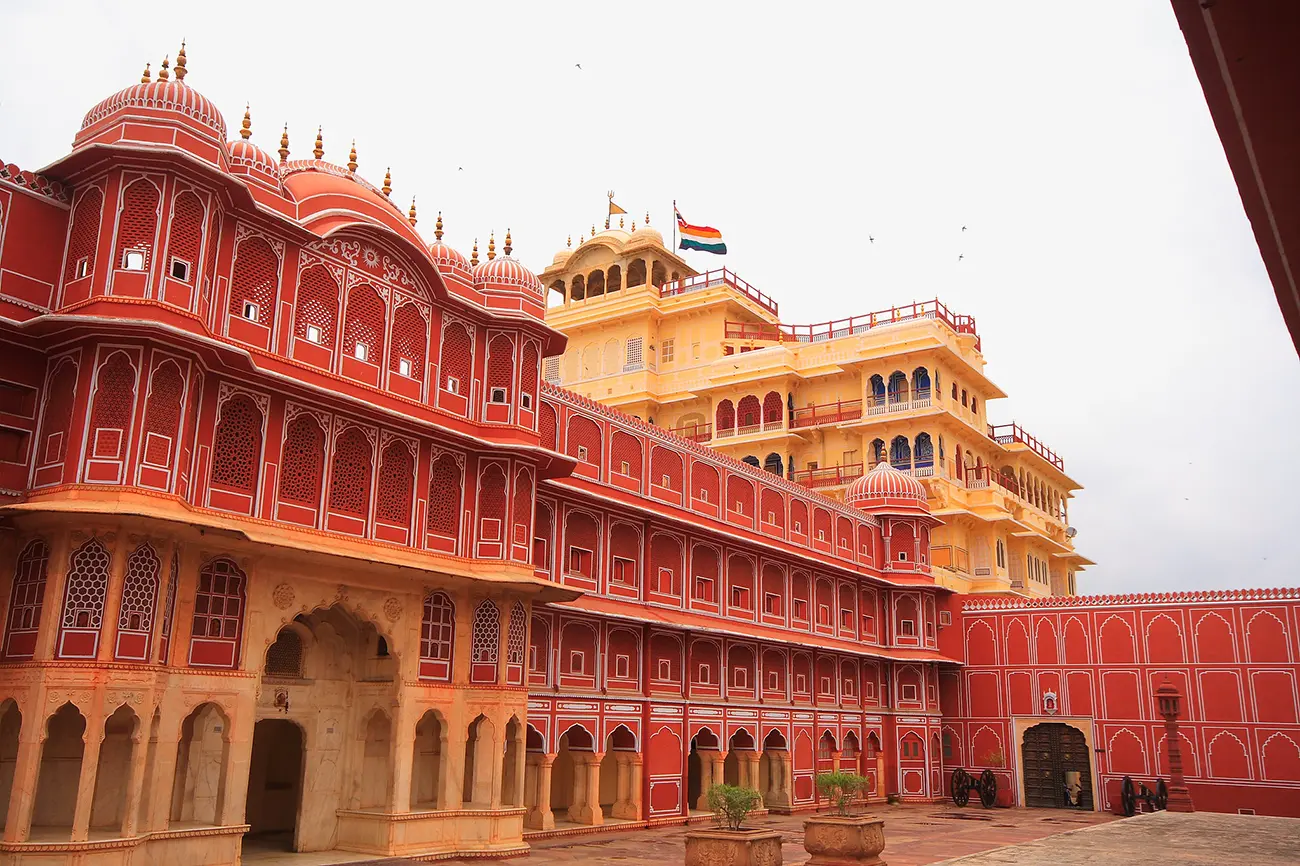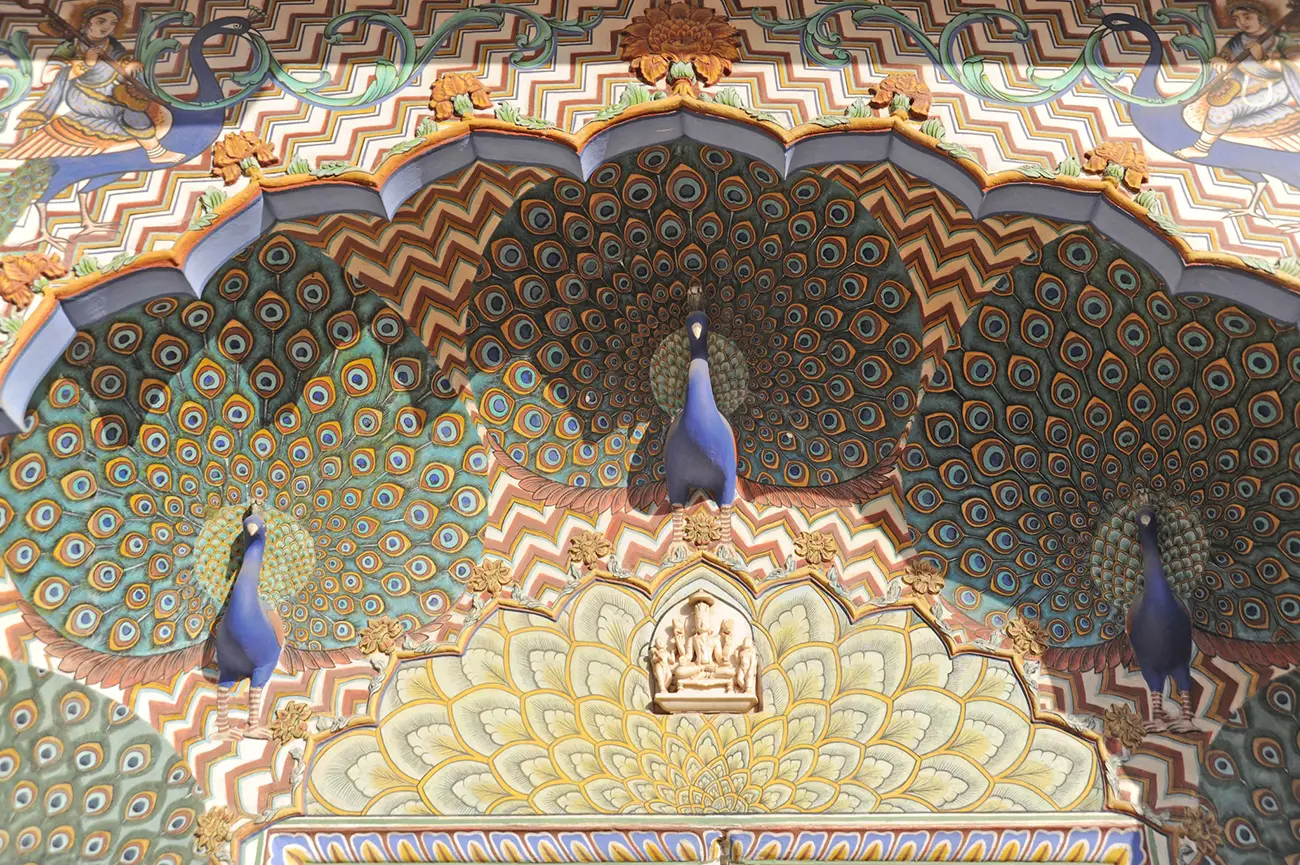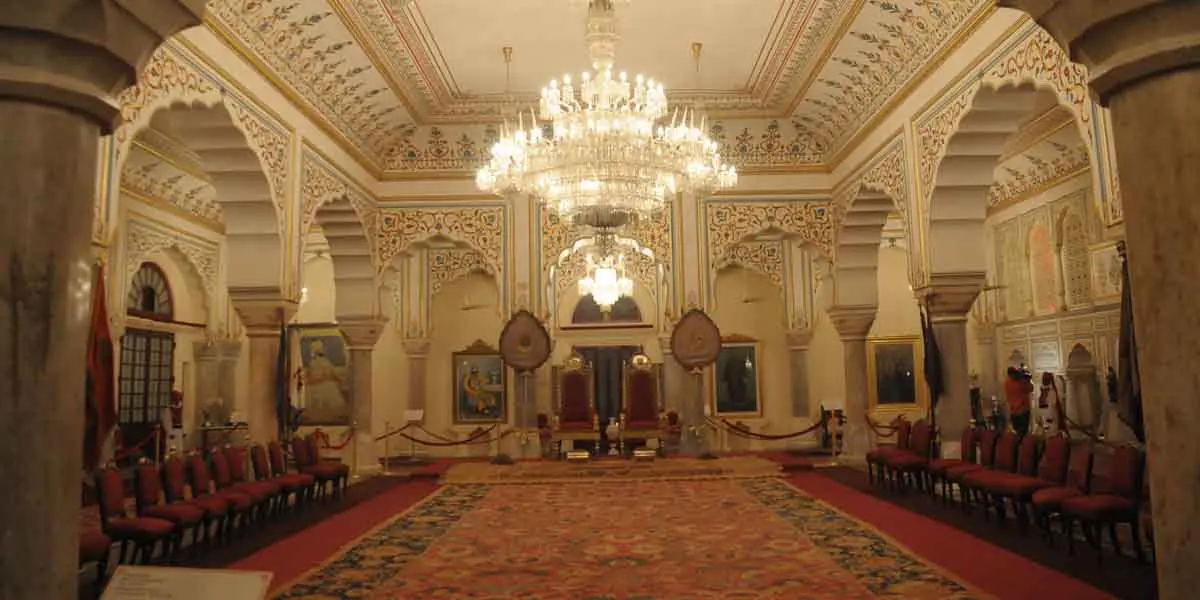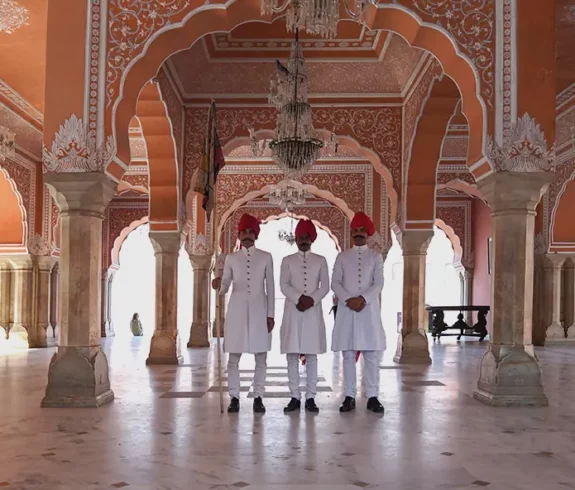The City Palace Museum in Jaipur highlights Jaipur’s royal history. It sits inside the grand City Palace complex at the heart of Jaipur’s old city. The museum holds treasures from the Jaipur royal family – weapons, clothing, paintings, and more. Visitors come here to step back into the time of Maharajas and see how life once was for Rajasthan’s rulers.
The museum is named after Maharaja Sawai Man Singh II of Jaipur. It opened to the public in the mid-20th century. It now showcases centuries of Jaipur’s heritage. The City Palace itself was the home of the Kachhwaha kings of Jaipur. Today, parts of the palace serve as a museum and event space, while the royal family still uses some areas. This blend of past and present visits here feels very special.
Historical Significance and Architecture
Maharaja Sawai Jai Singh II founded Jaipur and built the City Palace in the early 1700s. He left his old capital of Amber and moved here in 1727. He brought in architect Vidyadhar Bhattacharya to design the city and palace. Together, they followed ancient Vastu design rules. Construction of the palace began in 1729 and was finished around 1732. Over the following centuries, rulers added more buildings and decorations. The City Palace remained the seat of power for Jaipur’s kings until India’s independence.
The architecture is a colorful mix of styles. You will see strong Rajput features like high walls, balconies, and chhatris (domed pavilions). Mughal influences also appear in the arches, gardens, and ornamental stonework. European touches arrived later, such as clock towers and antique furnishings. All these styles blend. This fusion gives the palace its unique look.

- Chandra Mahal: This is the tallest, seven-story palace building. Only the ground floor is open to visitors as a museum (the upper floors are the private home of the royal family). Chandra Mahal means “Moon Palace.” Its facade is painted in pink and cream, with ornate balconies. You get great views of Jaipur from the top floors (when open).
- Mubarak Mahal: An ornate reception hall built in the late 19th century. It means “blessed palace.” The style is Indo-Saracenic (blending Islamic, Rajput, and European details). It was made to welcome guests. Today, it houses a Textile Gallery. The arches, carved pillars, and jali screens keep it cool in summer.
- Diwan-i-Aam: The Hall of Public Audience. The king met the ordinary people in this open pavilion and heard petitions. It has red marble flooring and beautiful columns. Two massive silver urns once stood here (now in the museum). These urns are world-famous for their size. They held holy Ganges water for months during the king’s journey to London. They weigh over 340 kg each!
- Diwan-i-Khas: The Hall of Private Audience. This hall was for special guests and official meetings. It has elegant archways and mirrors. Inside, you can see the silver throne of the Maharaja (now in an exhibition) and ornate gold chairs. It was a hall of luxury and power.
- Pritam Niwas Chowk: A beautiful inner courtyard leading to Chandra Mahal. It has four gilded gates, each representing a season and a Hindu deity. The Lotus Gate (summer) has lotus motifs, the Rose Gate (winter) is heavy with roses, the Peacock Gate (autumn) shows peacocks and flowers, and the Leheriya Gate (spring) has wave patterns. Each gate is a riot of color and very photogenic.
- Govind Dev Ji Temple: A small but sacred temple in the palace grounds. It dates back to the 19th century. It is dedicated to Lord Krishna and named after a holy idol from Brindavan. The temple is active with daily prayers and has a silver door. Visitors often pause here for a moment of peace.
Museum Exhibits and Collections
Inside the palace are many galleries filled with royal treasures. The collections tell stories about Jaipur’s history, art, and daily life. Highlights include:
- Textile Gallery: Located in Mubarak Mahal (the welcome hall). This gallery shows the clothing and fabrics of the Jaipur royals. You will see heavy embroidered gowns, delicate saris, velvet jackets, and richly patterned shawls. One display includes an enormous skirt worn by a Jaipur princess – it could spread to four feet wide! There are also royal uniforms, ceremonial dress, and fine Kashmiri shawls. The colors and details of the textiles are stunning.
- Armoury (Arms Museum): Found in the Maharani’s Palace wing. This room contains weapons that the royals used in battle and ceremonies. You can see tall swords, battle axes, shields, and old muskets. Some of the most interesting items include a wedding dagger with a special scissor action (used in royal ceremonies) and a gift sword from Queen Victoria. There are also vintage guns that could double as walking sticks. Each piece is decorated with gold, silver, and precious gems. The collection shows how craftsmanship and war tech met in royal Jaipur.
- Art Gallery (Paintings and Manuscripts): In the Chandra Mahal ground floor (called the Sawai Man Singh Museum). This gallery has royal paintings, portraits, and antique books. Look for miniature paintings depicting Jaipur’s past, painted on ivory or paper. You will also see old photo albums and portraits of Jaipur’s rulers. A famous item is a life-size painting of Sawai Ram Singh II (by the artist Sawai Ram Singh II himself). It is painted so skillfully that no matter where you stand, the Maharaja’s eyes follow you around the room! There are also carved paintings (pichhwai) on cloth, and illustrated manuscripts of epic tales like the Ramayana.
- Archives and Photography: Tucked into the museum are old photographs and records. The famous 19th-century photographer, Lala Deen Dayal, took many pictures of Jaipur. Some of these are on display. The archives also hold royal decrees and maps. These items are not large exhibits, but they add to the story of the palace and city.
- Silver Urns and Thrones: You can see precious royal artifacts in the courtyard of Diwan-i-Aam and the Sabha Niwas exhibition. The two giant silver water urns in Diwan-i-Aam (now on display inside) are a must-see. They were used to carry sacred water for the king. In the new Sabha Niwas gallery (opened in 2025), look for the Maharaja’s silver throne, canopy, and large royal portraits. These items give a sense of the ruler’s life and pageantry.
- Sabha Niwas Exhibition: This gallery is in the restored Hall of Public Audience. It opened recently and is very immersive. You will find rare treasures that have not been shown for decades. Exhibits include golden canopies used in processions, throne chairs, and life-size paintings of 18th-century maharajas. There is even a howdah (a royal elephant seat) that carried Queen Elizabeth II in 1961, and other royal canopies from that era. The hall has new lighting and audio-visual displays to bring the stories to life.
- Royal Carriages (Baaghi Khana): A hall of vintage transport used by the royals. It shows horse-drawn carriages, palanquins (palkis), and the colorful carts used in festivals. Notable items include a golden “mahadal” used to carry idols in parades, and the 1876 Victoria Buggi (a carriage presented to Jaipur by the Prince of Wales). The craftsmanship of these vehicles is intricate, with carved wood, metalwork, and upholstery. This display shows how the kings and gods traveled in style.

Architectural Highlights Outside the City Palace Museum
The City Palace Museum complex is also full of breathtaking architecture and art. As you walk around, notice:
- Pritam Niwas Chowk Gates: This courtyard is a photo favorite. The four decorative gates are covered in colorful enamel and gold. Each gate has a unique design. The bright Peacock Gate is especially famous. These gates mark the entrance to the main palace and symbolize the four seasons. Visitors often pause here to take pictures.
- Chandra Mahal: You can admire this building from the outside. It looms with seven tiers and tiny cupolas on top. The walls are painted with a pink and cream color scheme. Its windows and balconies are carved and painted. The roof has a small tower and a flag. Standing in front of it, you feel the palace’s grandeur.
- Mirror-work and Frescoes: Some rooms inside (like Rang Mandir and Shobha Niwas) are known for their mirror mosaics and wall paintings. In Rang Mandir (Hall of Mirrors), thousands of mirror tiles cover the walls and ceiling. When lit by candlelight or lamps, it shimmers like a starry sky. The nearby Shobha Niwas (Hall of Beauty) is decorated in gold leaf and colored glass. Hallways and domes across the palace often feature painted floral patterns and royal scenes (frescoes). Even if many of these are indoors, you can sometimes glimpse their sparkle from the open courtyards. Look for small decorative details on doors and windows, such as etchings and motifs of elephants, lotus flowers, and peacocks.

Visitor Information
- Opening Hours & Timings: The museum operates daily from 10:00 to 18:00, with final admission tickets available until 5:00 PM. Plan to arrive early if you want more time. The palace can get busy by late morning.
- Ticket Price: For entry to the City Palace Museum (courtyards and galleries), Indian visitors pay around ₹300 for adults and ₹150 for a child. Foreign visitors pay about ₹1000 for adults and ₹500 for a child. Tickets include access to all museum courtyards and galleries. (There are extra fees for special tours like the night show or royal tours, but these are optional.)
- Photos: Travelers can take pictures with small cameras. There is no extra fee for a handheld camera. Do not use tripods or selfie sticks, as they are not allowed. Also, avoid using flash inside dark rooms or on mirrors. Many areas, like the courtyards and halls, are fine for snapshots. Always follow the rules posted at entrances.
- Best Time to Visit: Winter (November to February) offers the best weather for walking around, as summers can be very hot. Try to visit early (10–11 AM) to see the palace in morning light and avoid crowds. Even late afternoon can be pleasant as the shadows grow long. Beware that midday (12–3 PM) can be scorching.
- Duration: A thorough visit can take 2–3 hours or more. The museum and grounds are extensive. To see most highlights, allow a good block of time. You may want to sit in the shady courtyards for a few minutes to rest and absorb the details.
- Accessibility: The City Palace has made efforts to be accessible. There are ramps and a golf cart service for visitors with limited mobility. You can request a wheelchair or cart at the entrance. The central courtyards and many halls are on one level or have ramps. However, some areas have steps. The palace has an accessible restroom near the entrance.
- Facilities: On-site, you will find restrooms, drinking water fountains, and a gift shop (Palace Atelier) selling local crafts and souvenirs. A restaurant (Baradari) also serves Indian and international dishes in a historic courtyard setting. A snack counter offers quick bites and drinks. ATMs are not available on site, so carry cash if needed.
Nearby Sights
When you visit the City Palace Museum, you are in Jaipur’s oldest district. Several other attractions are within easy reach:
- Jantar Mantar: This UNESCO-listed astronomical observatory is a short walk north of the palace (built by Jai Singh II in 1734). It has huge stone instruments that track the sun, stars, and moon. The giant sundial is especially famous. Jantar Mantar is a must-see for those interested in history and science.
- Hawa Mahal: West of the palace is the famous Palace of Winds. This rose-colored sandstone structure features 953 intricately designed windows (jharokhas) arranged in a lattice-like pattern. It was built so royal women could watch street processions unseen. You can walk or drive to Hawa Mahal from City Palace in about 5 minutes. It’s an excellent photo spot, especially in the early morning light.
- Bazaars: Surrounding the palace, Jaipur’s old bazaars are full of color and life. In Johari Bazaar, you will find jewelry and gemstones. In Bapu Bazaar and Tripolia Bazaar, you can buy textiles, pottery, and crafts. Stroll these markets for a real feel of the city. Bargain with shopkeepers and try local snacks (like samosa or sugarcane juice). The markets are vibrant in the late afternoon and evening.
- Govind Dev Ji Temple: Though part of the palace complex, this temple feels like a nearby sight. It lies in a garden at the edge of the palace grounds. It is one of Jaipur’s holiest temples so that it can get crowded during prayer times. If you have time, step inside (after taking off your shoes) for a brief visit.
Practical Tips
- Hire a Guide or Audio Tour: A knowledgeable guide can bring the history to life. They will point out stories behind each artifact and explain architectural details you might miss. Audio guides are also available at the ticket office. You will learn which stories lie behind the objects and rooms with a guide.
- Dress Comfortably: The palace has both open courtyards and indoor halls. Wear light, cool clothing in summer, and layers in winter mornings. Footwear should be comfortable for walking on marble floors and stone paths. Modest dress is appreciated, especially if you plan to visit the temple (cover shoulders and knees).
- Stay Hydrated: Jaipur can be hot, and you will be on your feet often. Carry a bottle of water (there are refill points inside). Use sunscreen and cover your head with a hat or scarf during sunny weather. Take breaks in the shade if you feel tired.
- Respect Local Customs: This is an active heritage site and a sacred space in places. Do not touch delicate artifacts or lean on palace railings. Speak quietly in the Govind Dev Ji Temple and remove your shoes and cap. Ask permission before taking photos of local people. Maintain a polite attitude – the guards and staff keep the palace running smoothly.
- Plan Your Visit: Buy tickets at the counters (you can skip lines by booking online if possible). There are two entrances: one by Chand Pol near Hawa Mahal, and another by Udai Pol on the southern side. The Chand Pol entrance drops you near Mubarak Mahal and the textile gallery. Try both entrances to avoid crowds. Also note that some areas (like Chandra Mahal private tours) may have separate access, so check in advance if interested.
The City Palace Museum, Jaipur, offers a decadent slice of Rajasthan’s royal heritage. Visitors walk through its courtyards, halls, and galleries into a living story of art, power, and tradition. This is not just a museum, but a journey through the history and culture of Jaipur’s kings. Whether you love history, art, or architecture, the City Palace Museum is an unforgettable part of an Indian trip. Enjoy your visit!
